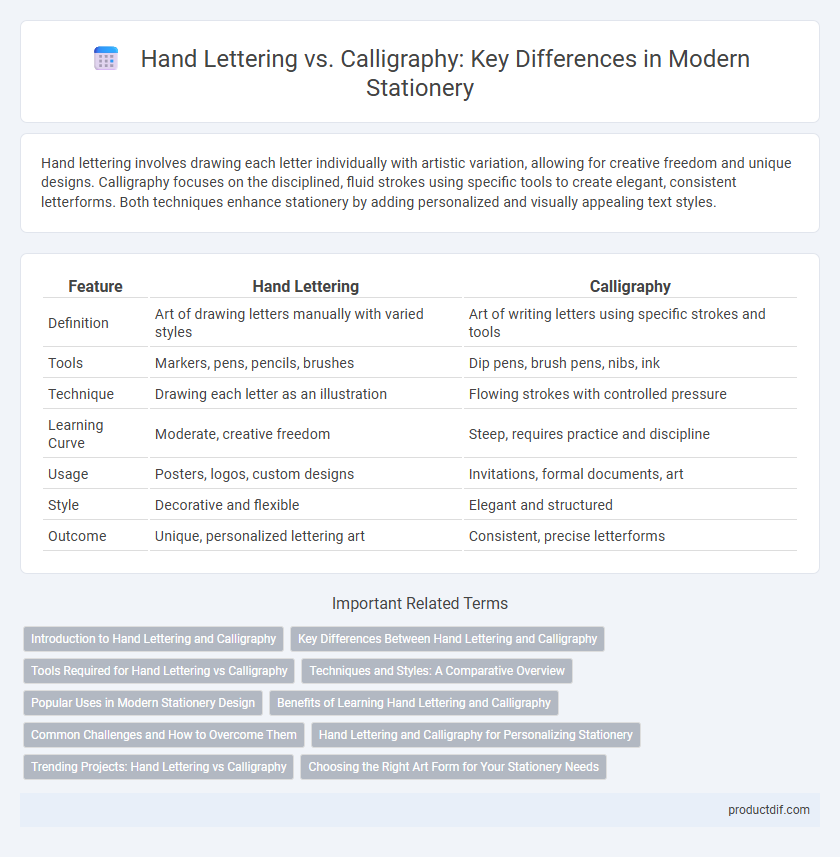Hand lettering involves drawing each letter individually with artistic variation, allowing for creative freedom and unique designs. Calligraphy focuses on the disciplined, fluid strokes using specific tools to create elegant, consistent letterforms. Both techniques enhance stationery by adding personalized and visually appealing text styles.
Table of Comparison
| Feature | Hand Lettering | Calligraphy |
|---|---|---|
| Definition | Art of drawing letters manually with varied styles | Art of writing letters using specific strokes and tools |
| Tools | Markers, pens, pencils, brushes | Dip pens, brush pens, nibs, ink |
| Technique | Drawing each letter as an illustration | Flowing strokes with controlled pressure |
| Learning Curve | Moderate, creative freedom | Steep, requires practice and discipline |
| Usage | Posters, logos, custom designs | Invitations, formal documents, art |
| Style | Decorative and flexible | Elegant and structured |
| Outcome | Unique, personalized lettering art | Consistent, precise letterforms |
Introduction to Hand Lettering and Calligraphy
Hand lettering involves drawing decorative letters individually, allowing creative freedom with shapes and styles, often used in modern design and stationery art. Calligraphy is the art of writing with a focused, flowing stroke technique using specialized pens or brushes, emphasizing traditional and elegant script forms. Both hand lettering and calligraphy enhance personalized stationery but differ in technique, tools, and visual impact.
Key Differences Between Hand Lettering and Calligraphy
Hand lettering involves drawing and illustrating letters with varied styles, often creating decorative compositions, while calligraphy focuses on forming letters through fluid, continuous strokes using specialized pens or brushes. Hand lettering allows for more artistic freedom and detailed embellishments, making each letter a unique design, whereas calligraphy emphasizes consistent, disciplined strokes and traditional scripts. The tools differ significantly: hand lettering uses markers, pencils, or pens for sketching, while calligraphy relies on dip pens, nibs, or brush pens to create elegant, flowing letterforms.
Tools Required for Hand Lettering vs Calligraphy
Hand lettering primarily requires basic tools such as fine-tip pens, markers, pencils, and brush pens to create varied strokes and lettering styles. Calligraphy demands specialized tools including dip pens with nibs, ink bottles, and brush pens designed explicitly for fluid, consistent strokes. Both techniques benefit from high-quality paper to prevent ink bleeding and enhance precision in artwork.
Techniques and Styles: A Comparative Overview
Hand lettering emphasizes drawing each letter with unique shapes and decorative elements, often using pencils, markers, or brush pens to create varied textures and line weights. Calligraphy relies on precise, fluid strokes executed with specialized tools like dip pens, brushes, or nibs, focusing on consistent letterforms and rhythm. Styles in hand lettering range from modern, illustrative, and whimsical, while calligraphy encompasses traditional scripts such as Copperplate, Italic, and Gothic.
Popular Uses in Modern Stationery Design
Hand lettering offers versatility in modern stationery design with its customizable and playful styles, making it popular for personalized cards, invitations, and branding materials. Calligraphy, characterized by elegant, flowing strokes, remains a favorite for formal events, wedding invitations, and luxury packaging. Both techniques enhance visual appeal by adding artistic, handcrafted elements that elevate the overall aesthetic of stationery products.
Benefits of Learning Hand Lettering and Calligraphy
Mastering hand lettering enhances personalized design skills, allowing for creative expression in custom stationery, invitations, and branding projects. Calligraphy improves fine motor skills and discipline, producing elegant, traditional scripts that elevate formal documents and artistic pieces. Both practices boost patience and attention to detail, fostering a deeper appreciation for typography and visual communication.
Common Challenges and How to Overcome Them
Hand lettering and calligraphy both demand steady hand control and patience, with common challenges including inconsistent stroke pressure and letter spacing. Overcoming these issues requires regular practice using quality brush pens or nibs, alongside guidelines or grids to maintain uniformity. Developing muscle memory through slow, deliberate strokes helps improve precision and flow in both artistic writing styles.
Hand Lettering and Calligraphy for Personalizing Stationery
Hand lettering and calligraphy both enhance personalized stationery by adding artistic flair, but hand lettering offers more flexibility with varied styles and playful designs. Calligraphy emphasizes traditional, elegant script created with specialized tools for fluid, consistent strokes ideal for formal invitations. Incorporating hand lettering allows customization with unique shapes and colors, making each stationery piece distinct and expressive.
Trending Projects: Hand Lettering vs Calligraphy
Trending projects in stationery highlight hand lettering and calligraphy as popular techniques for personalized designs. Hand lettering offers versatility with unique, custom styles ideal for greeting cards and planners, while calligraphy emphasizes elegant, flowing strokes suited for wedding invitations and formal documents. Both techniques drive creativity and are essential skills for artists and crafters seeking contemporary stationery trends.
Choosing the Right Art Form for Your Stationery Needs
Hand lettering offers flexibility and creativity with custom designs that suit modern, playful stationery, while calligraphy provides elegance and tradition through precise, flowing strokes ideal for formal invitations and certificates. Selecting the right art form depends on the desired tone and purpose of the stationery, with hand lettering enhancing casual or personalized projects and calligraphy elevating classic or ceremonial pieces. Both techniques enrich stationery by adding artistic value, so understanding their unique styles helps achieve the perfect aesthetic for any occasion.
Hand Lettering vs Calligraphy Infographic

 productdif.com
productdif.com